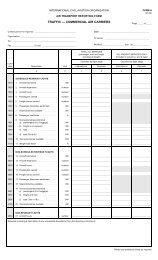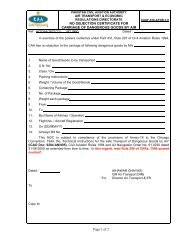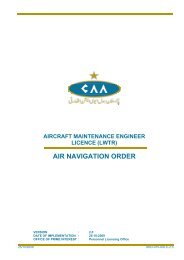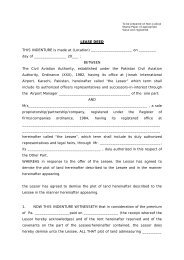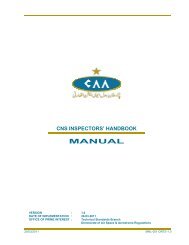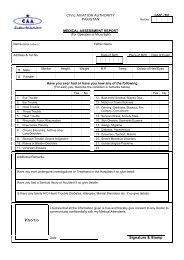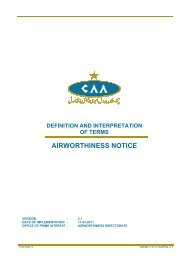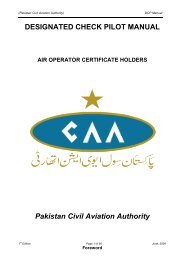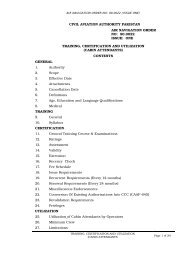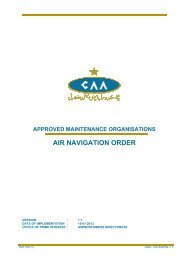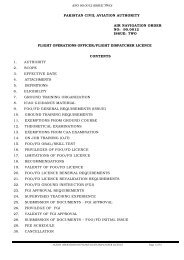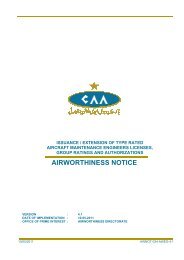state safety programme for pakistan manual - Civil Aviation Authority
state safety programme for pakistan manual - Civil Aviation Authority
state safety programme for pakistan manual - Civil Aviation Authority
Create successful ePaper yourself
Turn your PDF publications into a flip-book with our unique Google optimized e-Paper software.
STATE SAFETY PROGRAMME FOR PAKISTANE5.1.6 The PCAA regulatory framework in which it operates may change according tothe rapid technological or any other change factors; will induce changes.However PCAA will remain focused on <strong>safety</strong> improvement adopting thechanges as per the requirement of change suitable to its environment.E5.1.7 Safety improvements may not be very effective without the involvement andgood relationship of all sectors of Pakistan aviation industry. PCAA isdetermined to build on that relationship with industry through greater involvementfrom industry in the development of the Safety Plan and to share <strong>safety</strong> issuesas the results of that partnership.E5.2 PCAA SAFETY RISK TEAM:E5.2.1 To oversee aviation <strong>safety</strong> risks and identify the hazards, PCAA has establishedDirectorate of Safety and Quality Management System (SQMS) which works asthe Safety Risk Team (SRT). The SRT provides high-level oversight of and coordinatesthe <strong>safety</strong> risk management process. It is key to the success of the SRTand the management of risk in PCAA as a whole that the team is direct,proactive, delivers high quality in<strong>for</strong>mation, advice and proposes direction tosenior management.E5.2.2 The SQMS is tasked to seek and review <strong>safety</strong> in<strong>for</strong>mation and identify riskissues that are of strategic importance, ensure appropriate action plans areidentified to mitigate these risks, and propose documented <strong>safety</strong> plans to seniormanagement <strong>for</strong> their approval. The SQMS aims to assess the tolerability ofaviation risks using both objective and subjective methods.E5.2.3 In particular the SQMS is tasked to:E5.2.3.1 Identify risks.E5.2.3.2 Assess identified risks and supporting data.E5.2.3.3 Identify new and potential <strong>safety</strong> data sources and data handlingmethods.E5.2.3.4 Review and comment on the PCAA SRG Safety Per<strong>for</strong>manceIndicators paper, sponsoring further work where required.E5.2.3.5 Assess mitigating actions.E5.2.3.6 Share and co-ordinate <strong>safety</strong> in<strong>for</strong>mation amongst all PCAA wings(regulatory, ANS and Airport Services).E5.2.3.7 Be briefed with the aim of exploring possible new approaches oractions that may be adopted.E5.2.3.8 Constitute cross-functional team to assess specific issues andrecommend potential action plans to the SRT.E5.2.3.9 Agree and implement the methods to be used in preparing full SafetyPlans and Safety Plan Updates.E5.2.3.10 Contribute to and where possible improve Pakistan wide Safety RiskManagement.E5.3 SAFETY REQUIREMENTS FOR SERVICE PROVIDERS’ SMS:E5.3.1 The full impact of SMS on regulatory oversight has yet to be fully considered. Itis, there<strong>for</strong>e, important that PCAA management officials with oversightresponsibilities <strong>for</strong> service providers’ SMS have a common and clearunderstanding of the fundamental principles of SMS. In response, Directorate ofSQMS has arranged internal SMS training <strong>for</strong> PCAA personal.15/03/2010 Page 12 of 24 MNL-001-PDRG-1.0



